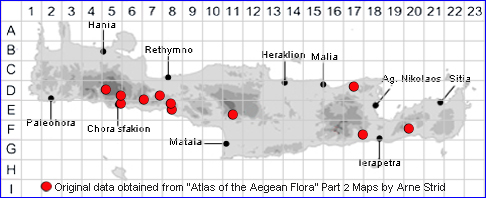

SPECIES DESCRIPTION
ALLIUM DILATATUM
Family and Genus:- See- ALLIACEAE/Sect. ALLIUM
Common Names:- None
Homotypic Synonyms:- Allium guttatum subsp. dilatatum
Meaning:- Allium (L) The ancient Latin name for garlic.
Dilatatum (L) Widened, spread out, dilated.
Bulbs:-
1) 1·5-2 cm diam, ovoid; outer tunics membranous.
Leaves:-
1) 3-4, 1-2 mm wide, filiform, tubular, fistulose, sheathing the lower 1/2-4/5 of the
stem, withered and functional at anthesis.
Flowers:-
1) Spathe, 1-valved, caducous.
2) Umbel, 1·5-4 cm diam, hemispherical, with 15-35 flowers, pedicels, 5-15 mm.
3) Perianth, narrowly cylindrical.
4) Perianth segments, white, with a broad green keel;
a) outer, 4 x 0·8-1·4 mm, lanceolate, acute or subacute.
b) inner, 4·5-5 x 0·8-1·6 mm, oblong-spathulate, truncate, the keel mucronate
and papillose.
5) Stamens, exserted:
a) outer 3 filaments, 4·5-5 mm, simple.
b) inner 3, with the basal lamina, nearly 3 times as long as the central
cusp, the lateral cusps twice as long as the central cusp.
6) Anthers, greenish.
Fruit:-
1) Capsule, 3·5-4 mm.
Key features:-
1) Outer perianth-segments, smooth or papillose on the mid-vein; inner widest at or
above the middle.
2) Inner and outer perianth-segments, subequal.
3) Basal part of the filament, less than twice as long as the central cusp.
Habitat:- Grows on calcareous cliffs, in rocky places and Pinus halepensis ssp.
brutia woodland 200-1000 m
Distribution:- Cretan endemic, probably related to A. guttatum. Described from
material collected in the Samaria gorge and subsequently found also in several
other localities.1)
1) "Atlas of the Aegean Flora" Book1, Arne Strid 2016.
Flowering time:- July-Oct
Photos by:- Fotis Samaritakis
Status:-
Conservation status (for threatened species): Rare (R) according to IUCN 1997
Protection status (for threatened species): Greek Presidential Decree 67/1981